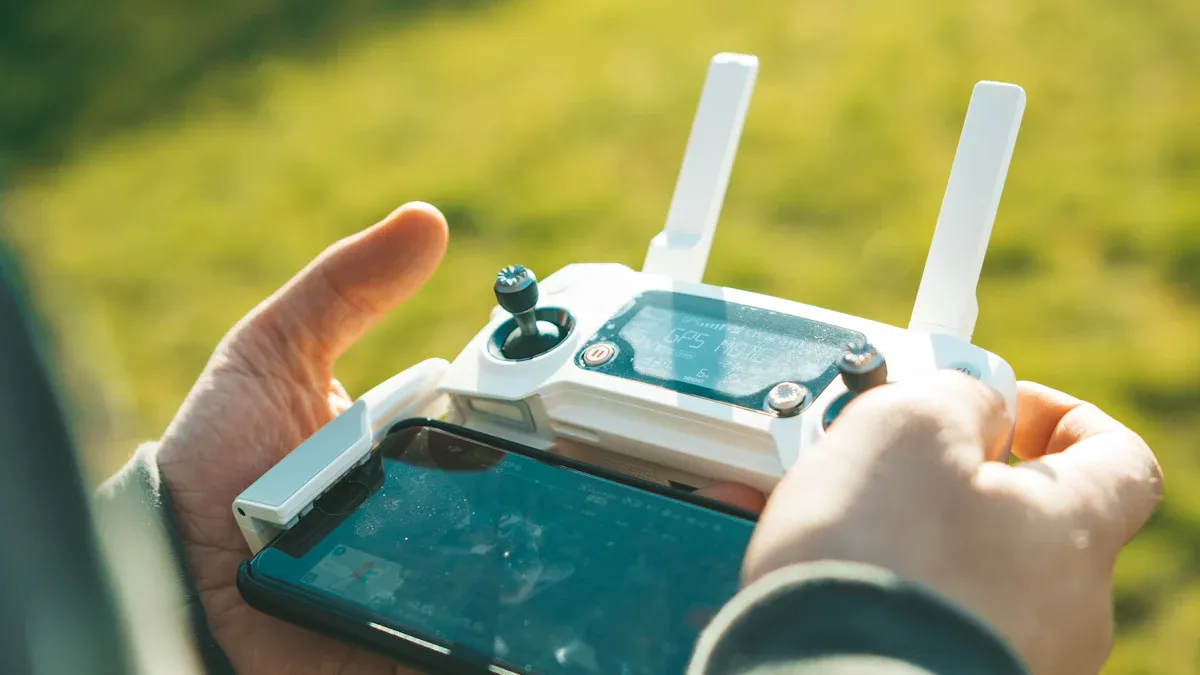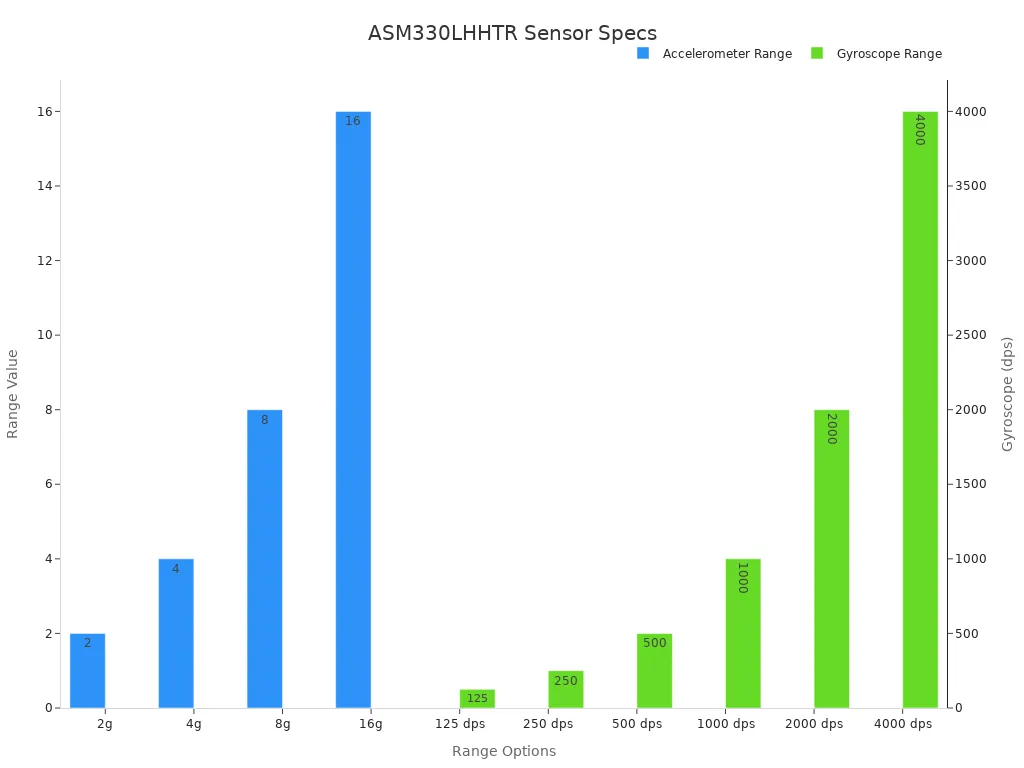How does the ASM330LHHTR sensor enhance drone flight control?

The ASM330LHHTR six-axis sensing application in drone flight control introduces advanced technology to enhance drone performance. Featuring a 3D accelerometer and a 3D gyroscope, the ASM330LHHTR sensor accurately measures movement and position. This precision aids drones in maintaining stability for smoother flying and improved steering capabilities. The sensor's adaptability to changing environments allows drones to respond swiftly. With its six-axis sensing, the ASM330LHHTR significantly enhances drone balance and movement, making it a crucial component of contemporary flying systems.
Key Takeaways
The ASM330LHHTR sensor has a 3D accelerometer and gyroscope. It helps drones track movement and stay steady.
Its six-axis sensing can detect tiny moves and quick spins. This improves how drones navigate, even in tough conditions.
The sensor uses little power, so batteries last longer. This allows drones to fly farther and work better.
It connects easily with SPI and I²C interfaces. This makes it useful for many drone purposes.
This sensor boosts drone performance for delivery, photos, and farming. It is important for today’s drone technology.
Overview of the ASM330LHHTR sensor
Key features and specifications
The ASM330LHHTR sensor is special because of its advanced features. It has a 3D accelerometer and a 3D gyroscope for accurate motion tracking. Here’s a simple breakdown of its main features:
Feature | Description |
|---|---|
Full-scale Acceleration Range | ±2/±4/±8/±16 g |
Angular Rate Range | ±125/±250/±500/±1000/±2000/±4000 dps |
Temperature Range | -40 to +105 °C |
Interface | SPI & I²C |
FIFO | 3 kbytes available |
This sensor can send data very fast, up to 6.66 kHz. Its small size and light weight make it perfect for drones where space and weight matter a lot.
Six-axis sensing capabilities
The ASM330LHHTR sensor uses six-axis sensing by combining its accelerometer and gyroscope. This lets it measure straight-line movement and spinning speed at the same time. Its wide range helps it detect both tiny movements and fast spins accurately.
Tip: The six-channel output improves dead-reckoning algorithms. These are important for drones flying without GPS.
The sensor also adjusts itself to work well in extreme temperatures, staying stable in tough conditions.
Benefits for drone applications
The ASM330LHHTR sensor offers many benefits for drones. It senses motion accurately, keeping drones steady even in rough weather. By combining data from different axes, it helps drones navigate better with precise positioning.
Here are some key benefits for drones:
Longer flights: The sensor uses less power, saving battery life.
Strong design: It works well in harsh environments without breaking.
Simple setup: The SPI and I²C interfaces make it easy to connect.

These features make the ASM330LHHTR sensor a key part of modern drones. It improves stability, navigation, and quick responses.
How the ASM330LHHTR sensor works
Motion sensing and data collection
The ASM330LHHTR sensor gathers motion data using its accelerometer and gyroscope. The accelerometer tracks straight movements like forward, backward, or upward motion. The gyroscope measures spinning or tilting movements. Together, they show how a drone moves in space.
This sensor collects data very quickly, up to 6.66 kHz. It gives real-time updates, helping drones adjust instantly. This keeps drones steady, even in tough flying conditions.
Note: The sensor’s wide range works well for both small and fast movements.
Sensor fusion algorithms
Sensor fusion algorithms mix data from the accelerometer and gyroscope. They clean up the data, removing errors, so drones get accurate information. For example, during turbulence, these algorithms separate real motion from outside forces.
The ASM330LHHTR sensor improves these algorithms with precise six-axis data. This helps drones know their position better. Flights become smoother, and navigation improves, especially where GPS is weak.
Tip: Sensor fusion algorithms with six-axis sensing are key for drones in changing environments.
Integration with drone systems
Adding the ASM330LHHTR sensor to drones is easy. Its SPI and I²C interfaces connect smoothly to flight controllers. Once installed, it acts like the drone’s “eyes,” watching motion and sending updates.
The sensor’s small size fits well in tight spaces. Its low power use means drones can fly longer. Whether for delivery, photos, or farming, this sensor adjusts to your drone’s needs.
Callout: The ASM330LHHTR sensor makes drones more stable, easier to navigate, and quicker to respond.
ASM330LHHTR six-axis sensing application in drone flight control

Keeping drones steady
The ASM330LHHTR sensor helps drones stay steady while flying. Its six-axis sensing can spot tiny motion changes. It watches the drone's movement and fixes any imbalance. This keeps the drone stable, even in windy or bumpy weather.
The sensor processes data very fast, so drones adjust quickly. For example, if wind pushes the drone, the sensor notices the shift. It sends data to the flight controller, which adjusts the motors. This quick action stops wobbling and keeps the drone on course.
Tip: A steady drone flies smoother and saves energy for longer flights.
Making navigation better
Good navigation is important for drones, especially near obstacles or weak GPS. The ASM330LHHTR sensor improves navigation by giving exact motion data. The accelerometer tracks straight moves, and the gyroscope tracks spins. Together, they show the drone's position and direction.
This sensor also helps with dead-reckoning, which works without GPS. It uses past movement to figure out the drone's location. This is helpful indoors or where GPS signals are weak.
Note: Better navigation lowers crash risks and helps drones reach their goals safely.
Adapting to changing environments
Sudden wind or temperature changes can affect drones. The ASM330LHHTR sensor helps drones handle these changes fast. It collects and processes data quickly to react in real time.
For example, if turbulence hits, the sensor spots it and alerts the controller. The controller adjusts the drone to stay steady and on track. The sensor also works in extreme heat or cold, making it reliable in tough places like deserts or mountains.
Callout: With the ASM330LHHTR sensor, drones become more stable and dependable, even in tough conditions.
Real-world uses of the ASM330LHHTR sensor in drones
Delivery drones for packages
The ASM330LHHTR sensor is key for delivery drones. It helps drones fly accurately to deliver packages on time. Its six-axis motion tracking keeps drones steady while flying. This is very helpful when carrying fragile items or flying in strong winds.
The sensor also helps with route planning. It works even without GPS, so drones can fly in areas with weak signals. This is great for cities where tall buildings block GPS signals.
Tip: With the ASM330LHHTR sensor, delivery drones are more reliable. They reduce delays and make customers happier.
Drones for photos and videos
For photographers and videographers, smooth flying is important. The ASM330LHHTR sensor keeps drones steady for clear pictures and videos. Its gyroscope reduces shaking, and its accelerometer keeps the drone balanced during tricky moves.
The sensor also makes drones respond faster. You can adjust the drone quickly to capture moving subjects or wide views. It ensures every shot is sharp and precise.
Callout: The ASM330LHHTR sensor helps create professional-quality photos and videos, even in tough conditions.
Drones for farming and industry
In farming and industry, drones with the ASM330LHHTR sensor do many jobs. They can map land, check crops, or inspect buildings. The sensor works well in extreme heat or cold, like deserts or snowy areas.
Its accurate motion sensing helps drones follow set paths perfectly. This is important for spraying crops or checking structures. The sensor gives reliable data, saving time and cutting costs.
Note: The ASM330LHHTR sensor turns drones into powerful tools for farming and industry tasks.
The ASM330LHHTR sensor changes how drones work. It gives accurate motion data, helping drones stay steady. Flights become smoother and more dependable. It also improves navigation, even when GPS signals are weak. The sensor reacts quickly, letting drones handle sudden changes in the environment.
Tip: As drones improve, the ASM330LHHTR sensor will lead new ideas.
This sensor helps drones do better in delivery, taking pictures, and work tasks. It’s an important part of today’s drone systems.
FAQ
What makes the ASM330LHHTR sensor special for drones?
The ASM330LHHTR sensor has a 3D accelerometer and gyroscope. These six-axis sensors give exact motion data. They help drones stay steady, move accurately, and react fast to changes.
How does the sensor keep drones steady?
The sensor notices tiny movements and sends quick updates. The flight controller uses this data to adjust the motors. This keeps the drone balanced, even in windy or rough weather.
Tip: A steady drone uses less power and flies more smoothly.
Can the ASM330LHHTR sensor handle tough conditions?
Yes, it works in temperatures from -40°C to +105°C. Its strong design makes it reliable in deserts, snow, or other harsh places.
Is it easy to add the sensor to drones?
Yes! The ASM330LHHTR sensor connects easily with SPI and I²C interfaces. Its small size and low power use make it perfect for drones.
Does the sensor work without GPS?
Yes, it supports dead-reckoning, which uses motion data to find location. This is helpful in places where GPS signals are weak or missing.
Note: This feature is great for flying indoors or in cities.
See Also
Uncover The Advantages Of STM32L151C8T6A In Sensors
Integrating ADXRS453BRGZ For Accurate Autopilot Systems
Understanding ADS1115IDGSR's Importance In Precision Data Collection
Employing INA226AIDGSR For Effective Remote Current Monitoring

